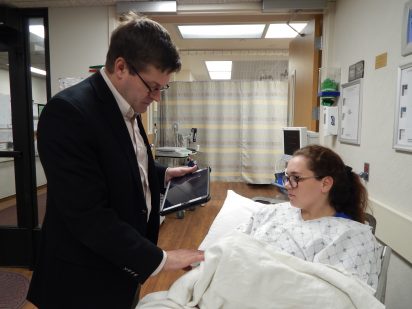(MINOT, ND)—Burn patients at Trinity Health now have the advantage of being evaluated by a burn specialist thanks to a new telehealth program that uses iPad technology to assess burns and manage ongoing care.
Trinity Health recently partnered with Regions Hospital in St. Paul, a nationally recognized burn center, to acquire devices called Teleburn iPads that provide initial assessment, treatment advice, and follow-up care for burn patients brought to the Emergency/Trauma Center.
Trauma Program Manager Rhonda Gunderson, RN, BSN, says the Teleburn iPad is a form of virtual medicine that works much like Skyping over the internet. But instead of talking to a friend or family member, you’re talking to a burn surgeon.
“When we have a patient with a burn injury, there’s a 1-800 number we call that connects us with Regions burn center,” Gunderson explains. “We provide patient information and request a consult with a burn surgeon. The surgeon calls us back and participates in a virtual face-to-face discussion with our doctors in the ER about how to proceed with the patient.”
The Teleburn iPad gives the burn surgeon an up-close view of the burn. Following specific instructions, a nurse in Trinity’s ER positions the iPad over the burn injury so the specialist can evaluate it in detail.
“The iPad serves as a tool to help us make several decisions,” Gunderson added. “Does the patient need to be transferred to Region’s burn center? Can we manage the injury locally, and if so, what treatment is recommended?”
She says the iPad consults also come in handy for follow-up care. Patients that have been sent to Regions Burn center and are returning home after discharge, will have a clinic visit scheduled with a Trinity Health surgeon, who then uses the Teleburn iPad to reconnect with the burn surgeon in St. Paul. The burn surgeon evaluates the healing process to see how treatment is progressing.
Gary Wease, MD, a general surgeon and medical director of Trinity’s Trauma Program, says burns, by their nature, are unique forms of trauma that benefit greatly from expertise that is highly specialized, especially when it involves deeper burns more prone to complications like infection and scarring.
“Burns are evaluated by how deep they are and how large an area they cover,” Dr. Wease said. “If a burn is very deep or covers 20 percent or more of the patient’s body, we usually refer that patient to a burn center. But many burns can be managed very well locally with various treatments designed to soothe the skin and promote healing.”
Gunderson says taking advantage of virtual care tools like Teleburn iPad achieves two objectives: It promotes patient satisfaction and gives caregivers an added measure of confidence knowing that their care is being guided by physician experts.
“The benefits extend to all members of the healthcare continuum,” she added, “especially patients, who now can enjoy greater convenience and access to specialty services. You can be in Minot, North Dakota, and get the opinion of a burn specialist. And you can have that specialist help manage your ongoing care without the frequent trips to St. Paul.”

